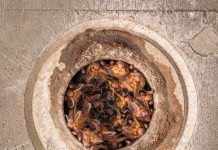State studying whether to reset health goal for perchlorate
The U.S. Environmental Protection Agency has moved toward a national drinking water standard for perchlorate that at first glance departs sharply from the interim standard it adopted in 2002, and has added to the confusion over safe levels of perchlorate in drinking water.
The report has inspired calls from an aerospace group for the state to raise its public health goal for the contaminant, but environmentalists and environmental officials said Monday that California likely will not be affected by the federal EPA and that the perchlorate plume in San Martin will only be governed by state law.
“We’re are interested in what they do, but the U.S. EPA action should not have any major impact on what we do,” said Allan Hirsch, spokesman for the Office of Environmental Health Hazard Assessment, part of the California Environmental Protection Agency. “We don’t feel we need to make any significant changes.”
OEHHA is currently deliberating whether to re-establish the public health goal for perchlorate, which it set last year as 6 parts per billion. The agency has been lobbied to lower the goal in light of a January National Academy of Sciences report that environmentalists saw as evidence supporting a goal of 1 part per billion, the standard set by the U.S. EPA in 2002.
But the EPA, charged by the federal government with making policy decisions based on the NAS report, sees it differently. Last month, the agency adopted the NAS’s reference dose, the amount of perchlorate a person can safely ingest daily, based on body weight. The EPA determined that the dose translates to a standard of about 24.5 parts per billion for all segments of the population.
That computation is based on a man weighing about 155 pounds. Environmentalists have argued that the standard needs to be revised downward, especially for pregnant women and small children, but the EPA has stated unequivocally that the 24.5 standard is protective for the most vulnerable populations.
“Whether you call it a leap or a step, it is a major change,” said Kevin Mayer, the EPA’s perchlorate coordinator in San Francisco. “Quite frankly, I was surprised when I saw the number. I had expected a longer discussion and deliberation period and it seemed pretty quick in the context of the many years we had been discussing this back and forth.”
Mayer did not participate in the EPA’s decision to translate the reference dose into a contamination level. Those discussions took place in Washington, D.C. Calls to the EPA officials in that city were not returned Monday. The report was issued under the auspices of the Interagency Perchlorate Steering Committee. Among the committee members were the U.S. Department of Agriculture, U.S. Food and Drug Administration, health services agencies of several states, including California, NASA and the Department of Defense.
James Strock, former state environmental secretary under Gov. Pete Wilson and spokesman for the Council on Water Quality, has praised the EPA’s reasoning. The Council represents the aerospace companies Lockheed Martin, Aerojet, Kerr-McGee Chemical and American Pacific Corp.
Strock said Monday that California officials should follow the lead of the EPA in analyzing the “extraordinary” NAS report, which he said was composed free of political bias.
“What’s important here is the science, and state and federal officials are in the very unusual position of having an NAS report related to the (perchlorate) topic,” Strock said. “The state has to make its own decision, but it’s clear they’ll take the NAS findings into account and that would point to a higher number considered safe for the public.”
A highly solvent sodium compound shown to affect thyroid function, perchlorate is an ingredient in rocket fuel. Members of the Council on Water Quality are responsible for many of the contaminated sites across the country. If the EPA does eventually set a drinking water standard, it could have a profound impact on the financial responsibilities of those companies that would have to clean up sites polluted above the standard.
About 150 of the 3,000 sites monitored by the EPA have tested for perchlorate at or above 4 parts per billion. Those sites provide water for about 11 million people, but there are substantially fewer sites that test at 10 or 20 parts per billion. The EPA has placed perchlorate on its contaminant candidate list, but it can not issue a national standard unless it demonstrates that doing so will cause a significant reduction of a public health threat.
“Depending on where the ‘safe’ number is, there may be very few public water supply systems that exceed it,” Mayer said. “There’s a novel interpretation of law by the defense department that unless a contaminant is somehow regulated, the cleanup may not be warranted.”
Although the number issued by the EPA is called a drinking water equivalent level, it is not the same as a drinking water standard. The DWEL, as the number is known, assumes that all perchlorate is ingested through water.
A number of studies, most recently research at Texas Tech University, that found perchlorate in the breast milk of every subject it tested in 18 states, have shown that perchlorate is in the nation’s food supply.
The EPA has several complex formulas it uses to determine the relative sources of contaminants, but it defaults to a ratio that assumes 20 percent of contaminant comes through drinking water, meaning a federal standard could actually fall as low as 5 parts per billion.
“They didn’t explain the DWEL well enough,” said Renee Sharp, a senior policy analyst with the Environmental Working Group in Oakland. “It makes it easier to confuse the issue. The number can actually be used to argue for a level lower than the public health goal.”
But Sharp and other environmental advocates are concerned that the EPA contends that a standard set for an adult male also is protective of pregnant women and children. They say that reasoning is evidence of political interference from the White House and the defense lobby.
“At this point, just watching how much meddling has gone on, we’ve gone beyond science and into the land of politics,” Sharp said.
Sujatha Jahagirdar, a clean water advocate for Environment California, said Monday that the EPA needs to pay more attention to the public’s desire for water that is contaminant-free.
“I think if you ask the public if they want rocket fuel in their water there will be a unanimous response,” Jahagirdar said. “The aerospace industry has every reason to push for a weak standard at the federal level, but the EPA’s job is to reflect public sentiment. That we’re even having this debate is absurd.”
The EPA can set a legally binding national standard, but states have the option of setting their own policies as long as they at least meet federal standards. So contaminated sites in California that are being cleaned through enforcement orders under federal Superfund legislation will have to be cleaned to the state’s public health goal.
“California has definitely taken a leadership role in protecting water supplies in the state,” Mayer said. OEHHA will decide in the next several weeks whether to reconsider the goal.
At the same time, the California Department of Health Services is in the process of setting a drinking water standard, which can not be lower than the health goal.
Gilroy Dispatch reporter Matt King can be reched at mk***@************ch.com or 847-7240.







